
Umbilicus rupestris, the navelwort, penny-pies or wall pennywort, is a fleshy, perennial, edible flowering plant in the stonecrop family Crassulaceae in the genus Umbilicus so named for its umbilicate (navel-like) leaves.

Cleistocactus strausii, the silver torch or wooly torch, is a perennial flowering plant in the family Cactaceae. It is native to mountainous regions of Department Tarija, Bolivia, at 1,500–3,000 m (4,921–9,843 ft).

Bergerocactus emoryi is a species of cactus, known commonly as the golden-spined cereus, golden snake cactus, velvet cactus or golden club cactus. It is a relatively small cactus, but it can form dense thickets or colonies, with the dense yellow spines giving off a velvety appearance when backlit by the sun. From April to May, yellow, green-tinged flowers emerge, which transform into reddish, globular fruit. This species is native to the California Floristic Province, and is found in northwestern Baja California and a small part of California, in San Diego County and on the southern Channel Islands. Where the Mediterranean climate of the California Floristic Province collides with the subtropical Sonoran Desert near El Rosario, hybrids with two other species of cacti are found. It is the sole member of the monotypic genus Bergerocactus, named after German botanist Alwin Berger.

Spartium junceum, known as Spanish broom, rush broom, or weaver's broom, it is a species of flowering plant in the family Fabaceae and the sole species in the genus Spartium. It is closely related to the other brooms.

Umbilicus is a genus of over ninety species of flowering plants in the family Crassulaceae. Many of its species have been given synonyms under different genera such as Rosularia, Cotyledon, and Chiastophyllum. However, those that remain in Umbilicus are listed below:
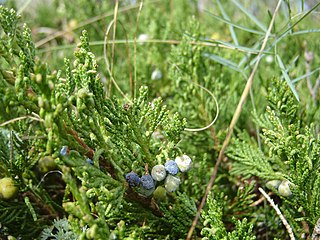
Juniperus horizontalis, the creeping juniper or creeping cedar, is a low-growing shrubby juniper native to northern North America, throughout most of Canada from Yukon east to Newfoundland, and in the United States in Alaska, and locally from Montana east to Maine, reaching its furthest south in Wyoming and northern Illinois.

Pennywort is a common name given to several different plants around the world. In general they have round leaves and a low-growing habit. Pennywort may refer to:
Echinodorus horizontalis is a species of plants in the Alismataceae. It is native to northern South America.
Umbilicus chrysanthus, known as Venus' navel or nabelkraut, is a succulent, perennial flowering plant in the family Crassulaceae, in the genus Umbilicus, which is found in the Alps. It is called Venusnabel in German, but the French translation nombril de Vénus refers to navelwort.

Iberodes linifolia, also known as Venus's navelwort, white-flower navelwort and petite bourrache, is an annual species of flowering plant native Southwestern Europe, but has naturalized elsewhere in Europe, North Africa, North America and Chile. The plant is small, growing to 30–40 cm (12–16 in) tall by 15 cm (6 in) wide, with blue-green foliage and tiny white or off-white flowers in Spring and Summer. It is distributed throughout dry open areas in full sun.

Scrophularia nodosa is a perennial herbaceous plant found in temperate regions of the Northern hemisphere except western North America. It grows in moist and cultivated waste ground.

Umbilicus oppositifolius, common names lamb's-tail and gold drop, is a succulent, perennial flowering plant, a species in the genus Umbilicus of the family Crassulaceae. It is endemic to shady mountain areas in the Caucasus.
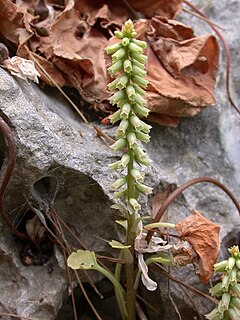
Umbilicus intermedius, the intermediate navelwort or common pennywort, is a succulent, perennial flowering plant in the stonecrop family Crassulaceae found in the shrublands and deserts of Israel and Lebanon.

Astroloba rubriflora is a succulent plant found in the mountainous Karoo area around Robertson, South Africa. It is listed as a Vulnerable species on the IUCN global Red List.
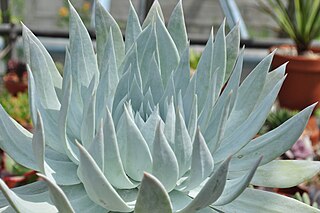
Dudleya brittonii, with the common names Britton's dudleya, Britton's liveforever and giant chalk dudleya, is a succulent plant in the family Crassulaceae. It is native to the coast of northern Baja California, Mexico. Both forms of the plant have yellow leaves on a clustered rosette atop a large reddish-purple peduncle. The white form of the plant has a chalky epicuticular wax that reflects light and reacts with water. The green form of the plant is more common and found throughout a wider range. It is among the largest of the Dudleya.

Umbilicus schmidtii is a flowering plant in the family Crassulaceae. The species is endemic to Cape Verde. It is listed as endangered by the IUCN.

Crassula ovata, commonly known as jade plant, lucky plant, money plant or money tree, is a succulent plant with small pink or white flowers that is native to the KwaZulu-Natal and Eastern Cape provinces of South Africa, and Mozambique; it is common as a houseplant worldwide. Much of its popularity stems from the low levels of care needed; the jade plant requires little water and can survive in most indoor conditions. It is sometimes referred to as the money tree; however, Pachira aquatica also has this nickname.

Leucospermum pedunculatum is an evergreen, low shrub of 15–30 cm (5.9–11.8 in) high spreading from a single stern upright stem, from the family Proteaceae. The powdered or hairless line-shaped to somewhat sickle-shaped leaves are 3–6 cm (1.2–2.4 in) long and 2–5 mm (0.08–0.20 in) wide. The stalked, individually set flower heads are globe-shaped, 2½−3 cm in diameter consist of initially white to pale cream flowers that eventually turn carmine. From the center of the flowers emerge straight styles that jointly give the impression of a pincushion. It is called white-trailing pincushion in English. It flowers from August to January, peaking in September. It is an endemic species that is restricted to a narrow strip on the south coast of the Western Cape province of South Africa.
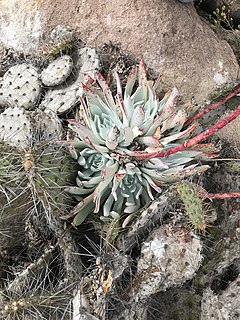
Dudleya candida is a species of perennial succulent plant in the family Crassulaceae known by common name as the Coronados liveforever. It is a rosette-forming, green to white-colored leaf succulent, and in bloom yellow flowers atop red stalks stand above the foliage. It has some visual similarities to the mainland Dudleya brittonii, and has found uses in horticulture as an ornamental plant. It is restricted to the Coronado Islands, an island group off of the extreme northern Baja California coast, visible from the United States.
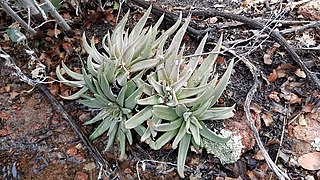
Dudleya abramsii subsp. abramsii is a species of succulent plant in the family Crassulaceae known by the common name as Abrams' liveforever. It is a small, delicate plant found growing among rocks, and is characterized by yellow flowers with a red tinge that emerge from May to July. It is native to the southern Sierra Nevada of California and the Peninsular Ranges across both the United States and Mexico.


















